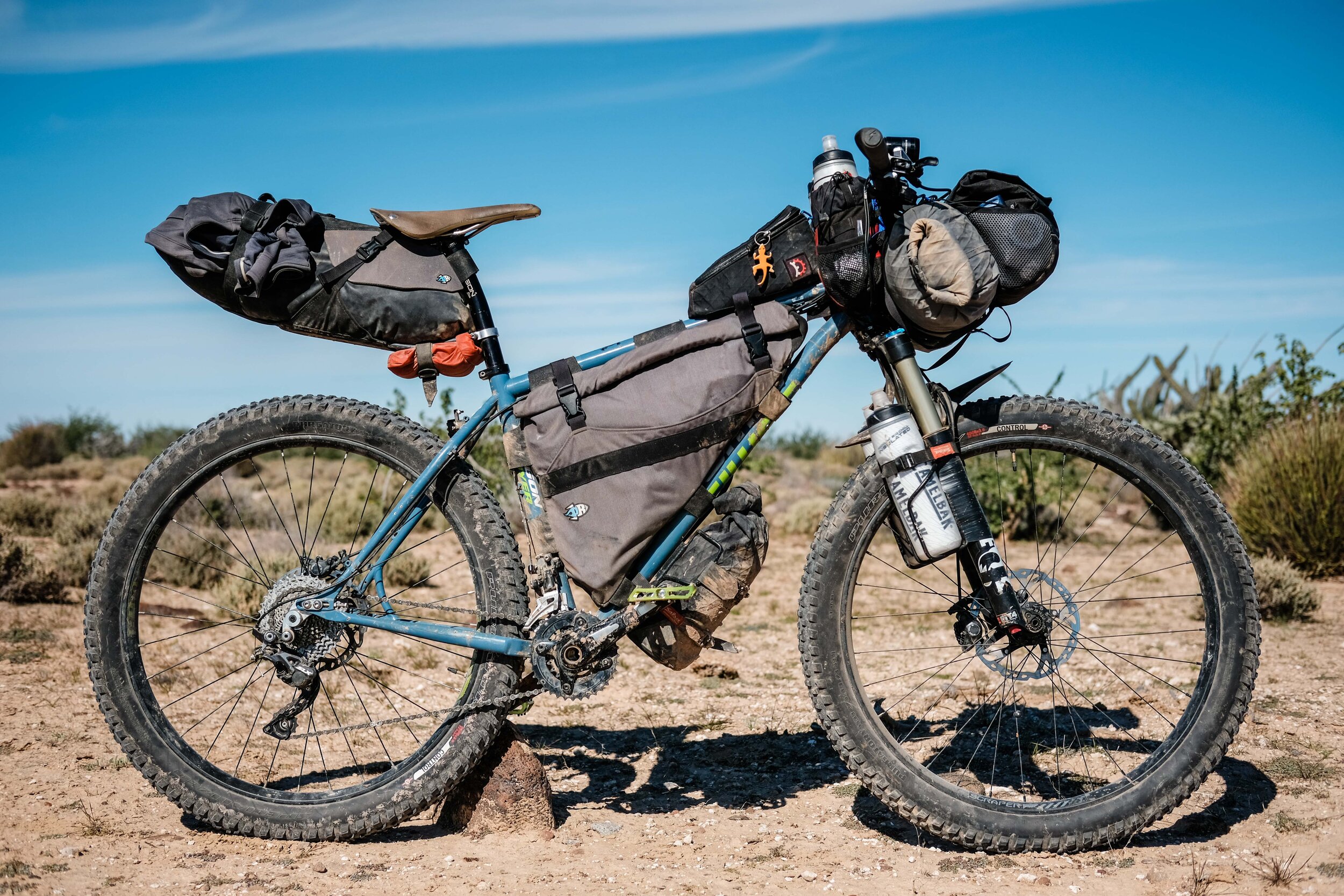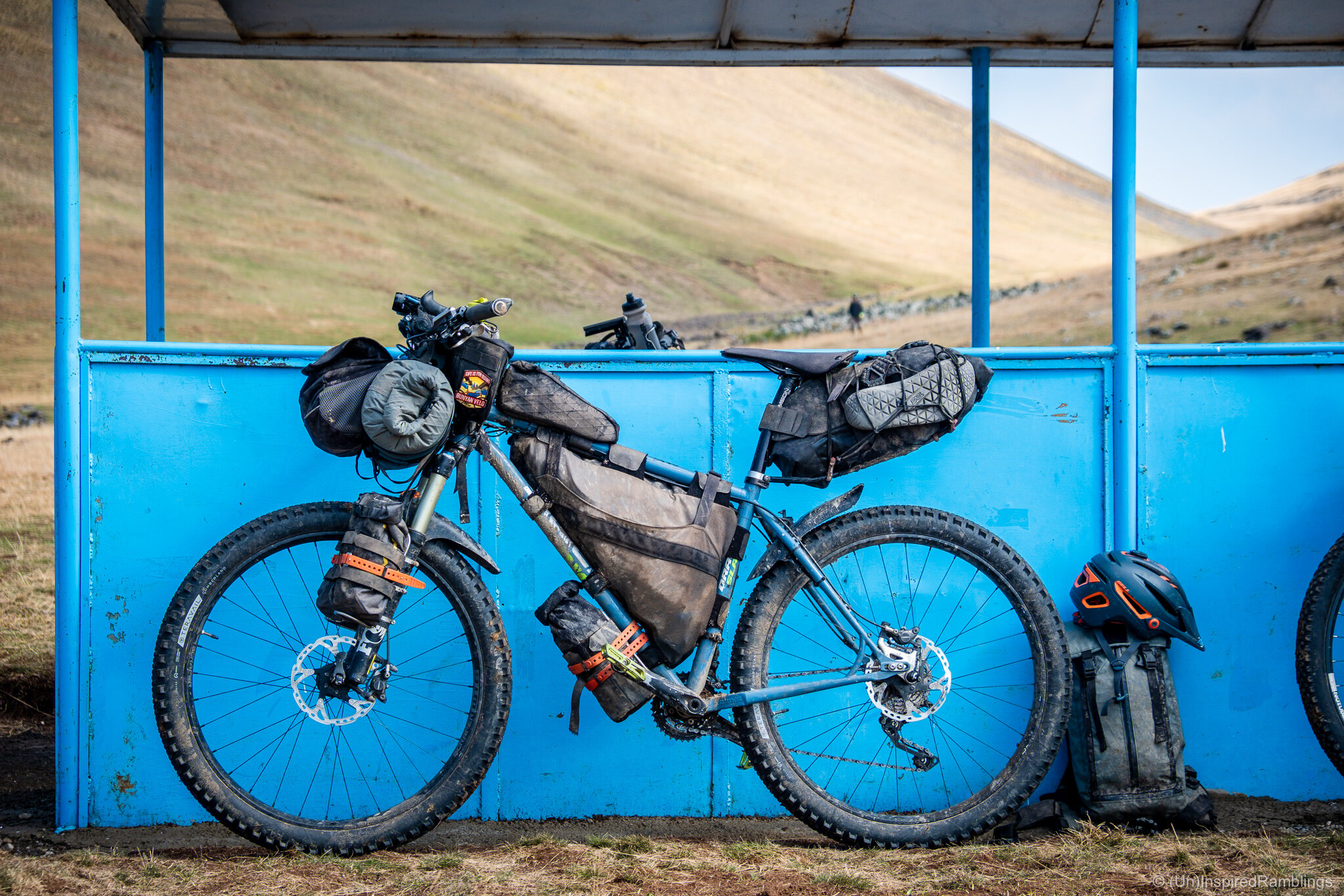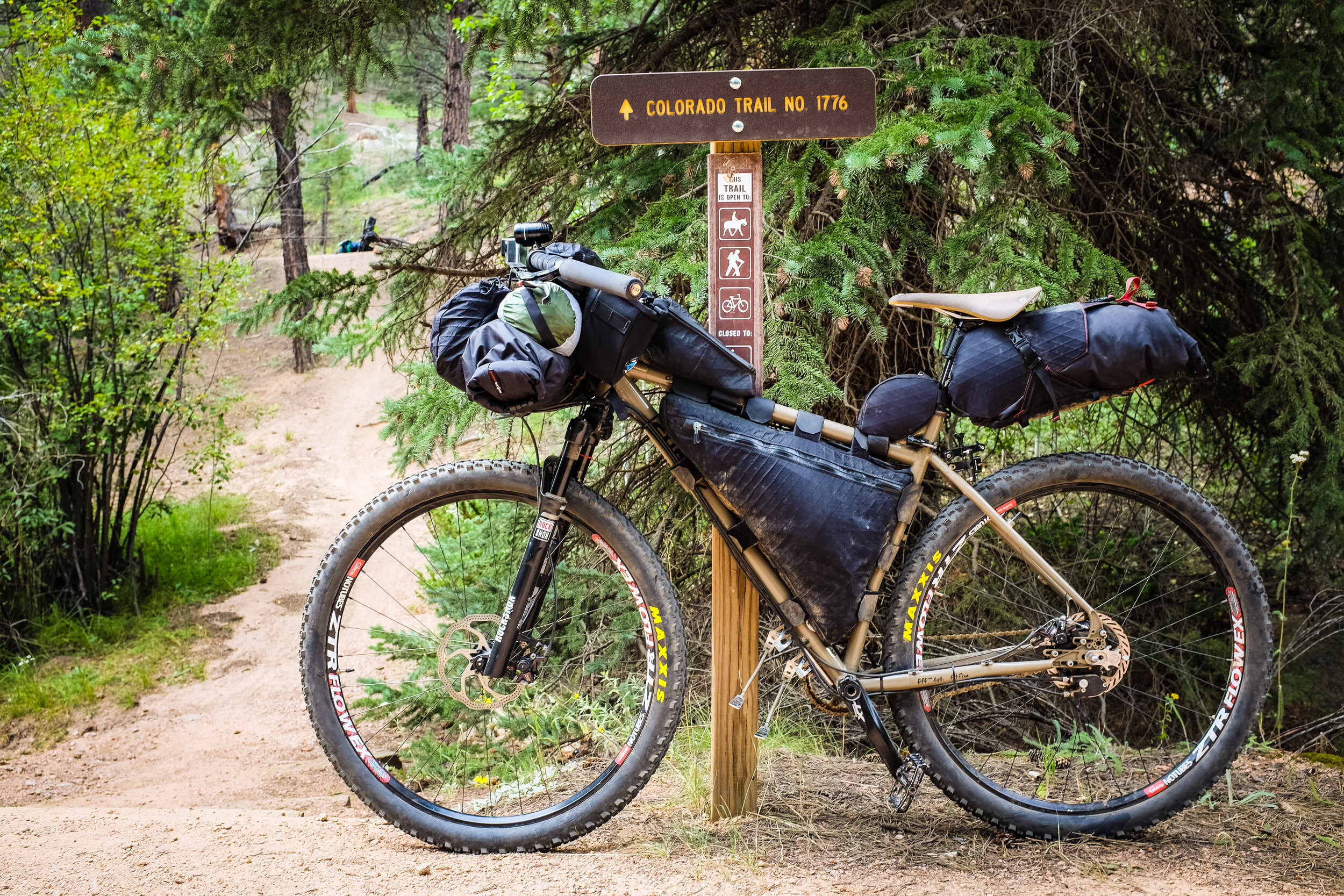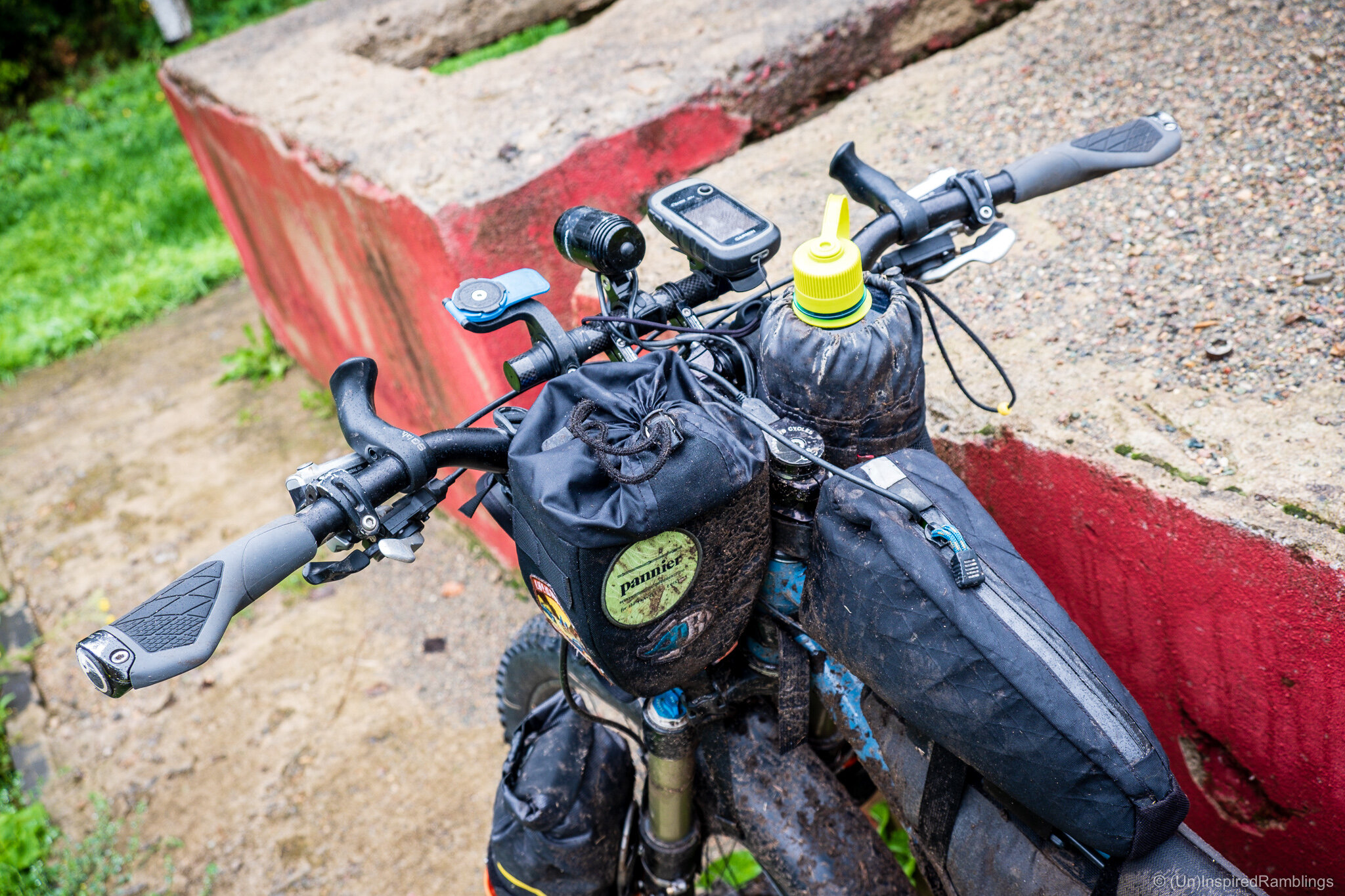An Introduction to Bikepacking Bags
[Post Updated August 2020]
When I returned from Baja in the spring of 2017, I was excited to give a presentation on bikepacking with Ben Smith at the Cycle Touring Festival . We talked a packed room through the differences between bikepacking and more traditional cycle touring, what it means in practice, the pros and cons, and a few different types of setup. We then each unpacked our loaded bikes in the room, to demonstrate how we manage to pack enough gear to survive into a space much smaller than that of your average touring cyclist setup.
We didn’t have a lot of time left for questions at the end of the talk, and quite a few people stayed on afterwards to look at the bikes more closely and ask specific questions about some of the key pieces of gear – particularly ‘where do you get this stuff?’. I guess that when you’ve been bikepacking for a while, you become fairly aware of who is making what, and the latest innovations, but if you’re just starting to consider the benefits of a bikepacking setup, then a lot of the smaller companies that make this gear might not be on your radar, although its becoming more visible as the mainstream companies get in on the game. Having said that, this gear is becoming a more and more common sight, and a lot of the larger mainstream companies now have bikepacking bikes and bags in their product lineups. But, as a followup to the talk, I agreed to put together some information on the key bits of equipment that we covered, and some suggestions of a number of brands that offer them.
Firstly, a quick point about waterproofness. Unlike many traditional panniers, bikepacking bags have generally not been fully waterproof until fairly recently. The material itself has been fairly good at keeping rain out, but seams and zips have meant that sustained rain or submersion would mean damp contents, unless packed within drybags inside. Lately, many brands have introduced properly waterproof products, using welded seams and in some cases, by finding alternatives to using zips. These include roll-top frame bags and top tube bags with flaps, which aren’t meant to be submerged in water but will keep out the rain.
My setup for the Baja Divide, 2017. Porcelain Rocket framebag, Mr Fusion seatpack & Anything Bag (under downtube to keep the dirt off my water bottle). Alpamayo Designs bar harness, drybag & waterproof pocket. Revelate Designs Gas Tank & Mountain Feedbags.
Bikepacking bags can generally be split into 4 basic categories based on where they fit on the bike: handlebar bags, frame bags, seatpacks, and accessory bags (which often fit on or around the top tube, but can also include fork mounted bags).
Handlebar bags
These generally take the form of a dry bag or ‘nearly-dry’ bag that usually attach to the handlebars with two straps, with a third strap looping around the headtube for stabilisation. Some designs use a couple of straps attached around the fork crown for stabilisation instead. There are three basic designs of this style of handlebar bags. The lightest and simplest option is to simply strap a drybag to the bars using webbing straps, or rubberised straps such as Voile straps. This can work just fine, and is cheap, but you the bag isn’t supported particularly well and so may sag in places or work loose, and can rub and wear through over time. Some companies make drybags with loops attached to thread the straps through, and help hold the bag in place. A slightly more functional version of this is where the drybag attaches to the bars directly using straps that are stitched or welded to the bag itself. Often the bag features additional tougher material in areas likely to rub, and potentially spacers to allow the bag to sit slightly away from the bars to give space for gear cables and brake cables/hoses. This can give more support to the bag, reduce the risk of the bag loosening. The downsides of this are that if the dry bag wears through, you need to replacing the whole bag and integrated straps might be more expensive than just finding a new drybag.
An alternative design is where the drybag sits in a separate harness, and the harness is attached to the bars. Whilst this latter design can be heavier and bulkier, it allows the drybag to be removed and reinstalled easily and quickly which is great when you want to bring your gear inside your tent or hotel room without having to faff too much unstrapping everything. This design also allows you to carry other items in the harness (e.g. a tent in its own bag) instead of, or as well as, the main drybag. It’s also generally easy to replace the drybag with a different size or shape, or if the original bag wears out. The downsides can be that this arrangement is heavier and potentially bulkier than the simpler designs.
Most brands also produce a separate pocket that either connects to dedicated clips on the main bag or harness, or that can be attached by itself directly to the bars when not using the main bag / harness. Usually the design allows you to carry small items like a waterproof shell or tent poles between the main bag and the pocket. The main bags range in size from roughly 9-14 litres. Alpkit also offer drybags in a range of sizes with loops to accommodate separate straps to hold them directly on the bars. These come in larger sizes – up to 20 litres.
In the last few years, the use of a more traditional ‘saddlebag’ style bag on the bars has become more popular, and many companies are now producing modern versions of these bags with up to date materials. There are many benefits to this design, which has a flapped lid that opens in a more conventional manner: the contents are much more easily accessible on the go (especially when using drop bars), and the bags easier to pack and more flexible, often incorporating an extendable skirt and long top flap to accommodate additional/oversize loads. One of the main issues with the use of the dry bag style bikepacking setups is that you can be really limited on spare capacity and loading up on food supplies when you get the chance can be tricky. The saddlebag style of bag generally makes this a lot simpler. I’ve written a bit more on the use of this style of bags in this post. A step on from this is the use of a basket up front, and a number of companies are now making modern bikepacking bags that fit securely and neatly into these. They may not work so well for technical mountain biking or with a suspension fork, but for more gravel touring, they’re a nice blend of old and new, and potentially even more flexible than the other designs mentioned above.
As these bags mount on the handlebars, its best to try to keep the contents light to avoid impacting too much on the steering. I have tended to put gear that I’ll only need in camp, and that I definitely need to keep dry in mine: down quilt, down jacket, merino wool baselayer, sleeping pad, spare socks and perhaps some additional clothes that I won’t need in the day, if I have them. On a mountain bike with front suspension, it’s often not advisable to get the largest (deepest) size, as the height/diameter of the bag is so large that it can rub the front wheel when the suspension compresses, but with flat handlebars, as is usual on a mountain bike, there is no limit on the width of the bag used, so a shallower, but wider bag can be fully filled. Conversely, on a rigid drop bar bike it could be better to get a larger diameter bag. The drop bars will mean that a dry bag style set-up can’t be filled to its full width, but the lack of fork compression reduces the likelihood of the bag rubbing the front tyre, and so the increased diameter of the bag maximises the available capacity in this situation. Either way, its important to measure the gap between your bars (for drop bars) and between the bars and front tyre, before you commit.
Frame bags
These fit within the main triangle of the bike frame, secured with straps to the top tube, down tube and seat tube. There are generally three types. Partial frame bags only fill the top part of the main triangle, often still allowing the use of water bottle cages. Its pretty easy to find the right size to fit your frame. Full frame bags fill most of the space in the main triangle, and need a bit more care to find the correct fit. Many brands make two different sets of full frame bags, each designed to fit common mountain bike or road bike geometries, and each in a range of sizes. Some brands also offer custom frame bags, which are made to specifically fit your bike, based on a cardboard template that you provide. This is particularly useful if you have an unusual frame, or for example, a full suspension mountain bike. Frame bags are a good place to carry heavy gear, as the weight will be low and central, minimising the impact on handling.
The majority of frame bags use zip closures, but several companies now make roll top bags, which helps keep the water out and gets rid of the zip, which often fail first. Having said that, zips are. available that will keep most rain out and companies such as Revelate Designs incorporate stretchy fabric around rugged oversized zips to allow some stretch when zipped up a heavily stuffed bag, to take the strain off the zip. Full frame bags often allow the main compartment to be split into two horizontally or vertically, and have a slim pocket on one side. Most have ports to allow water reservoir hoses to exit the bag and be clipped onto the bars for easy access on the go, or for battery cables to connect to lights or dynamo hub outputs. Its often also possible, when ordering a custom made bag especially, to specify the width of the bag throughout, or just at the very front to squeeze in some extra capacity where there is no risk of it rubbing your knees as you pedal.
Seatpacks
Mirroring the handlebar bags, these generally come in three designs: a simple drybag strapped to the saddle rails and seatpost using separate straps; a more functional shaped drybag design with integrated straps, and specific areas of fabric to provide support and deal with high wear; and a design with a separate harness containing those features but where the drybag can easily be removed whilst leaving the harness attached to the bike. Seatpacks can have a tendency to waggle when loaded, especially on rough terrain, and much of the design is focused on minimising this movement. Some innovative models include the use of a minimal metal rail clamped to the seatpost to support the bag from below, or mounted to the saddle rails to suspend the bag from above, both designs aimed at preventing any movement. Recent models have also been released which work with dropper seatposts. Similarly to handlebar bags, seatpacks generally range in size from around 8-15 litres.
The increasing use of modern versions of the traditional saddlebag designs for bikepacking obviously also extends to using them as saddlebags, as well as mounted to the bars. Some use a traditional metal mini-rack bag support but others, such as the BagsxBird Goldback shown above mount with two wooden dowels for structure, and rubber Voile straps, making them just as stable as most other setups. There are compromises in using a wide bag, especially at the rear, but this may depend on the kind of riding you’re doing. I’ve written a little more about this here.
The boundaries are blurring in other ways also. It’s now possible to get strong and robust minimalist pannier style racks (for example, the Tumbleweed T Rack and Mini Pannier Rack), which provide enough support for a set of minimalist panniers. The main option for using traditional panniers without being too overloaded used to be to use a set of smaller front panniers on the rear, but this still left you with a relatively bulky shape, and with the downsides of a traditional pannier attachment system (rattly on rough terrain, prone to breakage). Companies such as Revelate Designs and Porcelain Rocket both make more minimalist panniers that can help give you extended capacity (or get round the difficulties of using a seat pack on a small framed bike) without giving you the excessive capacity, bulk and weight of more traditional panniers. These minimalist racks are also starting to offer bottle/anything cage mounts on the legs, enabling you to simply strap a dry bag to the top and use the legs for additional water carrying capacity. In fact, as designs continue to evolve, there is even now a lightweight rack with an integrated bag - see Tailfin in the list of manufacturers below.
Accessory bags
These generally fit along the top tube, either against the seatpost or head tube (often known as Gas Tank / Fuel Pod / Top Tube bags) and have zip closures. They’re good for storing things you need frequently, such as phones, small cameras and snacks. Also useful are draw-cord closure bags which are suspended at the apex of the stem and handlebars (known as Feedbags, Stem Bag/Cells or Food Pouches) and are great for carrying water bottles or lots of snacks. Lately, alternative closure mechanisms such as flaps or drybag style roll tops have been introduced to reduce the need for zips and improve water resistance.
A few manufacturers also make bags to fit in other locations, such as under the downtube (either attaching directly to the frame, or sitting in a large bottle or cargo cage), or suspended in the centre of Jones bars, as well as bags designed to carry specific gear (for example, cameras).
Bag Manufacturers
This isn’t going to be a comprehensive review of all the options, but an overview of some of the key companies that I’ve come across or would recommend, with a particular focus on those that are readily available in the UK. Tim Moss, who runs the Cycle Touring Festival with his wife Laura, has an exhaustive spreadsheet of all the bikepacking bag providers, as well as weights, price and sizes on his website here, although it is now a few years old (2016). Alee at CyclingAbout also has a comprehensive list of all bikepacking bag manufacturers and products, by country, last updated in 2019 here. Bikepacking.com has heaps of reviews of different bags, and a number of round-ups of similar styles bags all together - its worth using their search function and seeing what you can find.
Alpamayo Designs – Sadly no longer in operation, this was a small company, Alpamayo Designs run by Paul and Sam, who met in South America and rode the Andes together. I mention them here because the bar harness and drybag I have from them is one of my favourites, and my go-to setup for my Jamis Dragonslayer, and is in a few of the photos above.
Alpkit – The UK outdoor gear manufacturer started making value for money bikepacking gear a couple of years ago and now offers a big range of bags and accessories, including custom frame bags and many waterproof options. Their range includes cheaper but effective options based around simple drybags designed to be strapped directly to the bike. I have a one of their large top tube bags and a couple of stem cells, though neither is in use just at the moment.
Apidura – Established about 7 years ago, Apidura produce a comprehensive range of gear, including their completely waterproof Expedition series. The gear is manufactured in the Far East, but distributed globally, so delivery is quick. I have a set of the waterproof Expedition Fork Packs, and have in the past used a waterproof handlebar bag, and a partial frame bag.
Bags By Bird: Run by Jay Ritchey, BagsXBird primarily makes modern versions of a traditional saddlebag design. They are really well made and innovative, using up to date materials, double wooden dowels and rubber Voile straps for a solid setup. I have a set of their Goldback bags for my Bombtrack Hook. They’re made on a monthly batch basis in the US, but Jay will happily post to the UK.
Carradice - The classic British touring saddlebag company has branched out into bikepacking gear, with a few interesting features.
Ortlieb – The stalwart of traditional touring gear has turned its expertise to bikepacking gear, making a small range of solid, waterpoof bags.
Porcelain Rocket – One of the original manufacturers, run by Scott Felter. They are a small operation of just 2 people, and have recently decided to scale back their range, no longer offering custom items with long lead times in order to focus on a smaller range of innovative products: seatpacks and a waterproof, roll-top framebag. I’ve included them here as I love their gear, but based in Calgary, Canada, the downside is that you can only order direct from them, which means paying international postage and potentially import duty, if you’re based in the UK. I currently use their Mr Fusion seatpack (which has lightweight steel rails clamped to the seatpost to avoid any bag movement) and custom framebag on the Dragonslayer.
Restrap – Based in Yorkshire, Restrap make a small but uniquely designed range of bags from their family run workshop.
Revelate Designs – The other original manufacturer of modern day bikepacking gear, Eric Parsons’ company make a comprehensive range of products, and continue to innovate with waterproof bags, elasticated fabric around framebag zippers to reduce stress, and micro panniers for extra capacity when needed. Manufactured in Anchorage, Alaska, you can order direct or through a number of suppliers in the UK and Europe, although sometimes finding stock can be an issue. I currently use a Gas Tank and partial frame bag and previously, their Harness/Saltyroll & Pocket handlebar setup.
Straight Cut Designs - A relatively recent brand established by Ross O’Reilly, based in Edinburgh, UK. Ross makes a range of really clean looking bags, including custom framebags.
Tailfin - Based in Bristol, UK, Tailfin make an innovative range of minimalist carbon / alloy rear racks that can carry panniers and/or their own trunk bag. These are like nothing you’ve ever seen before but are a really clever design that should fit any bike and that can be used for a lightweight bikepacking setup, with a dropper post, or for a more loaded trip.
Wildcat Gear – The UK’s first custom bikepacking gear company, Wildcat are a small company based in Scotland (previously in Wales), run by Beth and Ian Barrington. They had a full range of gear, with innovative designs, including custom framebags, and seatpacks and handlebar setups based around the use of waterproof drybags. They stopped operations for a year but are just about to start up again. I’ve used their Lion harness, a custom framebag on a full suspension bike and also have their Tom Cat bag for my Jones bars on the Ogre.
Wizard Works - Another new brand in the UK, set up by Harry Major building stock and custom bags in a range of funky designs. I’ve got a new camera bag and a stem cell large enough to hold a 1 litre Nalgene bottle.
In addition to the above brands, you can tell that bikepacking is hitting the mainstream as Specialized, Blackburn, and Topeak are all developing their own ranges. As well as ordering direct, many of the above brands are available at Pannier, Backcountry Biking, The Bikemonger, Keep Pedalling, and Always Riding.
Information and Inspiration
It’s also worth mentioning that there are a few websites that provide a wealth of information, reviews and inspiration for all things bikepacking. My favourites are here:
Bikepacking.com Comprehensive, beautifully written and photographed, this site has some of the most experienced bikepackers in the world providing content – Logan Watts (founder), Cass Gilbert, Joe Cruz, Miles Arbour, Lucas Winzenburg to name but a few. New content is added constantly, with bike and gear reviews, epic route guides and inspirational stories.
Pannier.cc Beautifully designed and illustrated by Stefan Amato, Pannier provides a UK- and European-focused collection of stories in their Journal, sells cycle touring, bikepacking and camping gear in their online store, and have started to run tours and events. They also provide gear hire – a great way of trying before you buy.
Bearbones Bikepacking Stuart Wright, founder, organiser and chief tea drinker of the Welsh Ride Thing and Bearbones 200 bikepacking events hosts a very active online forum that gives access to a wealth of information and knowledgeable bikepackers in the UK. A great place to trawl for information or ask for advice, and to arrange to meet strangers in a wet field in deepest Wales. Stu also reviews gear, and sells a small selection of gear.
Bikepacker US based magazine style site, full of reviews, reports, news and films from all over the world.
I will follow up on this post with more on some of the other gear that drew a lot of questions at the festival – lightweight shelters, sleeping bags / quilts, cooking gear etc. In the meantime, if you have any comments on the gear mentioned above, or recommendations of your own, please just add them in the comments below.




























